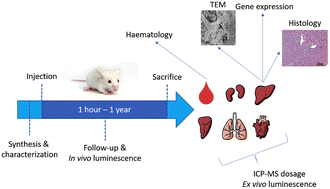Fate and biological impact of persistent luminescence nanoparticles after injection in mice: a one-year follow-up†
Abstract
Persistent luminescence nanoparticles (PLNPs) are attracting growing interest for non-invasive optical imaging of tissues with a high signal to noise ratio. PLNPs can emit a persistent luminescence signal through the tissue transparency window for several minutes, after UV light excitation before systemic administration or directly in vivo through visible irradiation, allowing us to get rid of the autofluorescence signal of tissues. PLNPs constitute a promising alternative to the commercially available optical near infrared probes thanks to their versatile functionalization capabilities for improvement of the circulation time in the blood stream. Nevertheless, while biodistribution for a short time is well known, the long-term fate and toxicity of the PLNP's inorganic core after injection have not been dealt with in depth. Here we extend the current knowledge on ZnGa1.995O4Cr0.005 NPs (or ZGO) with a one-year follow-up of their fate after a single systemic administration in mice. We investigated the organ tissue uptake of ZGO with two different coatings and determined their intracellular processing up to one year after injection. The biopersistence of ZGO was assessed, with a long-term retention, quantified by ICP-MS, mostly in the liver and spleen, parallel with a loss of their luminescence properties. The analysis of the toxicity related to combining an animal's weight, key hematological and metabolic markers, histological observations of liver tissues and quantification of the expression of 31 genes linked to different metabolic reactions did not reveal any signs of noxiousness, from the macro scale to the molecular level. Therefore, the ZGO imaging probe has been proven to be a safe and relevant candidate for preclinical studies, allowing its long term use without any in vivo disturbance of the general metabolism.



 Please wait while we load your content...
Please wait while we load your content...